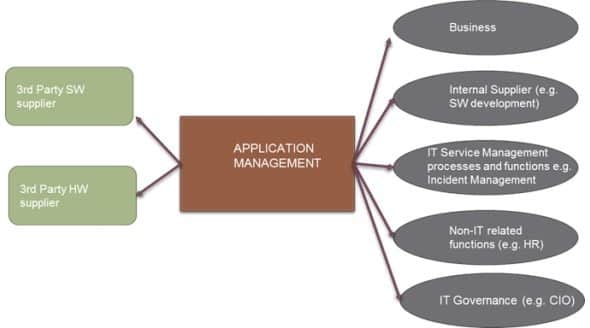I spoke to a lady from HR (Human Resources) when she was upset; she was trying to explain to me that she doesn’t understand questions from developers and that she doesn’t know how to explain to them exactly what she needs. And… when they change something, some other functionality suddenly doesn’t work… It’s a common occurrence in many real-life situations, but also a perfect example to explain the ITIL Application Management function.
Let’s start from theory. According to ITIL (Service Operation edition), Application Management is “the function responsible for managing applications throughout their lifecycle.” Most probably, you noticed that here we are talking about the function, in contrast to the process, which is the topic of most of the other blog posts.
A function is a group of people or tools or some other resources used to carry out process activities (see, there is a clear connection with processes). Applications are the focus of the Application Management function. And, finally, application lifecycle means the time from idea to operational, i.e., improvement stage.
What is it all about?
It’s about managing applications. Well, if that sounds simple – believe me, it’s not. Consider your working environment. Applications are everywhere: on your phone, on your computer, in the production line, on the photocopy machine, at the doors to your office building…etc. The number of applications that we use is not decreasing; quite the contrary – it’s increasing. So is the complexity. Applications are cross-connected; they have multiple interfaces (between them or to some other systems) and they come from various resources (e.g., internal or external) and, as the most important element, they have to fulfill business purposes.
Hmm, business purposes? Yes, that’s crucial. Today’s business strongly relies on applications that the company uses. Take for example supply chain management (management of the flow of goods, i.e., from procurement of raw materials to delivery of the products) where every step in the process has to be followed by an activity in the application. Like one of my clients – they are replacing paper documents and Excel sheets (not to mention things that are kept in someone’s head) with a more sophisticated system. The reason is that they “get lost” quite often and don’t have information about efficiency (how much product do we get for a certain amount of raw materials), costs, or the situation in the warehouse. This is a straightforward business purpose that needs to be fulfilled.
Objectives of the Application Management function
First, let me make something clear. Applications do not equal services. Take the operating system of your laptop as an example. That’s an application (maybe in a special form, but it is). A service that covers the operating system is a desktop service (this is the usual service name, but, of course, could be something else).
One of the important goals of the Application Management function is to help to decide whether to “make or buy.” This means that someone (Application Management) has to consider the business need, resources available, and market offerings and advise about new in-house development or purchase. Usually, Application Management will make a suggestion and some governance role (CIO, CTO, head of IT or some kind of steering committee) will make the decision.
Another important role is to work together with development. Correct, Application Management (managing) is not application development (having expertise to develop). But, the closer they work together, the better the results.
Here are a few other objectives of the Application Management function (AM):
Corporate standards – for example, are we going to develop a stand-alone application or server based, or what kind of user interface application will it have (e.g., web-based), what kind of databases are we using… A contemporary firm has to have governance in many areas; applications are just one of them.
Resource management – this includes both internal (the already mentioned application development) as well as external resources and activities like management, selection, communication, coordination…etc.
Training and documentation – for both your own people (i.e., involved in AM) as well as end users.
Operations support – The Technical Management function and IT Operations function are involved in daily activities as well as Incident and Problem Management personnel. But, AM is there to support them in their tasks because AM has expert knowledge in the area of applications used.
Improvement – as ITIL emphasizes many times (you will find it in every process, i.e., function) – improvement is continuous and works on all interfaces throughout the service lifecycle. It’s the same with AM. People involved in AM have deep knowledge about the application, and are a good source of improvement initiatives.
Figure: Application Management is connected with various functions
Knowledge ownership
I have a customer who uses Application Management on the third support level. And that’s fine, as long as the previous two levels know where to find the expertise. Applications are part of all services and processes inside the company, so it’s important that they are properly managed and that there is a clear ownership of knowledge related to them.
To implement ISO 20000 easily and efficiently, use our ISO 20000 Documentation Toolkit that provides step-by-step guidance for full ISO 20000 compliance.

 Branimir Valentic
Branimir Valentic 



